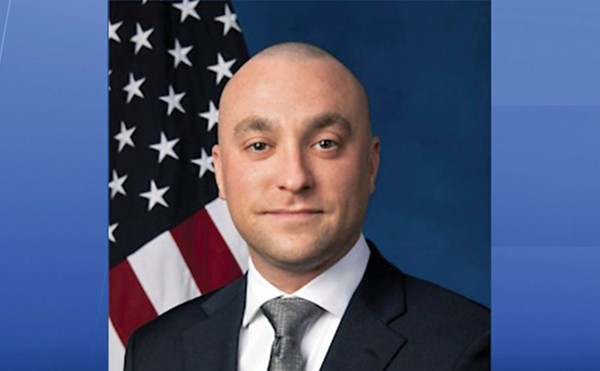The way Lori Smith remembers it, she and her husband Patrick really didn't have much of a choice, and she didn't really care anymore what people thought. Patrick was in a bed at MetroHealth, his leg recently amputated, the latest in five years of surgeries, and she had $850,000 or so in medical bills stacked up at home. She was also getting sick of eating peanut butter sandwiches to save money.
The furniture had been sold and the wedding rings too, and neither she nor her husband were working, he with heart problems and his leg (stemming from a staph infection) and she with lupus and other ailments. They both had worked at a hospital — and lost their jobs for a few reasons — and had been uninsured since 2010. (They don't want to talk about the hospital they worked for, as there are legal claims still being adjudicated.)
So as time went by, they were in what hospitals call the "self-pay" category of patients, which means the hospital isn't really thrilled with you being around, because the self-pay people usually don't. Lori tried to patch together some charity care and get qualified for disability, but that stuff was always floating through the system without definitive answers, and the prescription medications were now costing about $4,000 a month. They had a little income, thanks to her daughter's job, but didn't quite hit Medicaid level, and they couldn't afford what she and Patrick needed in care either.
And she remembered thinking how no one was talking about moving Patrick out of the hospital bed and letting him lie in the street, but at times it felt like that.
"We'd been working our whole lives and we needed help and it wasn't a handout like people say, but I felt like people thought we wanted care for free," she says now. "It was a vicious cycle. Because we'd be getting another hospital bill that we knew in no shape or form we'd be able to pay."
But while Patrick was recovering from that latest surgery, the hospital counselors came in and told Lori about a new plan MetroHealth was adopting called Care Plus. By cobbling together about $30 million in Cuyahoga County public money, and getting about twice that from the federal government in matching funds, MetroHealth was going to offer Medicaid to about 30,000 people who made between 100 and 133 percent of the poverty line cut-off. The program was started in 2013, and it was seen as a precursor to a future plan to do a Medicaid expansion statewide as part of the Affordable Care Act. In fact, the program was designed to come to an end just as Ohio considered signing up for its own Medicaid expansion, which it did, starting in January 2014.
So Lori signed up in the spring of 2013 and they have now been moved into national Medicaid expansion based on the MetroHealth model. She and her husband have been covered for their care since, which is good for any number of reasons, least of which because Patrick was back in the hospital recently for his heart problems.
Health care analysts, think-tank policy wonks and insurance executives all watched the MetroHealth experience in 2013 to see if signing up more people for Medicaid was a good idea, especially as the Medicaid expansion that states were being encouraged to adopt was moving into the legislative decision phase. What everyone was wondering was this: Would signing people up for Medicaid get them out of going to the expensive emergency room for basic treatment? And would more people see primary care physicians for treatment that perhaps would help prevent bigger problems down the line, as diseases often worsen over time without proper routine attention?
Here's what MetroHealth found in getting 30,000 people out of self-pay and into government-pay: Emergency room visits dropped by 60 percent, while primary care visits increased by 50 percent. The money the hospital had saved was about $450,000 more per month than they had projected. And surveys of the patients found they were in better health than they had been a year earlier.
It reinforced a basic tenet in health care financial dynamics. Going to an emergency room for a non-life threatening condition costs the hospital about $5,000 per visit. Going to a doctor's office to get treated for the same non-life threatening condition costs about $120. And people with health care coverage tend to go to the doctor's office more than the emergency room because, well, the doctor will see them without a down payment and they don't have to wait around for several hours (probably).
One other major point that the MetroHealth experiment proved: A business and patient care model that finds ways to keep people out of the hospital is much better at caring for them in the hospital. This works whether a person is on Medicaid or has private insurance. Get them in treatment prior to serious emergency care, and the costs go down significantly. It also holds down costs for the entire populace: Estimates put the tab at about $1,000 a year that is passed on to the insured by the non-insured who show up to emergency rooms and can't, or don't, pay.
Dr. James Misak, associate director of family medicine for MetroHealth, said the basic notion for access to care is a way to cut costs, pure and simple. "A person with diabetes without access to care might have renal failure which could lead to needed dialysis or amputation of a leg," he says. "Those are costly implications from a lack of care that can be avoided. Access to insurance leads to access to care which leads to a healthier population which over time costs less to care for."
This was a big change in thinking for the medical community, one that had been percolating for some time but got forced to the front burner by the Affordable Care Act. The old model said the real money was to be made by getting patients into the hospital and doing all sorts of tests and treatments and surgeries. "Fee for service" is the name used for that model, because the more services the patient gets the more fees the hospital gets. The new model — in part because of changes with Obamacare — says the better money now is made by keeping people out of the hospital. The new model fuses incentives into the program that makes it more profitable if their patients stay healthy and get fewer services.
Nowhere is that change of thinking more apparent than at the Cleveland Clinic, an institution once called "the Clinical Factory" by one author. The local hospital system — one routinely recognized as among the best in the world in a number of specialties, one that made heart bypass surgery a run-of-the-mill procedure, one led by a surgeon who has done more than 22,000 heart operations in his career — is now figuring out that maybe finding ways to avoid some of those assembly line heart operations is better for the patient and the bottom line.
For the Cleveland Clinic and other health care systems in states that have approved Medicaid expansion, there are many reasons to change that way of ingrained thinking. Most think the changes that Obamacare has brought involve changes in the way we pay for health care. But it is also very much about how the health care is delivered, and there are many reasons hospitals are embracing those changes. In the case of the Cleveland Clinic, there are about 300 million of them.
This week, the Supreme Court of the United States heard arguments on a case that might upend the whole Obamacare revolution. Many think the case, which might pull government subsidies on the private Obamacare insurance exchanges of many states, is flimsy and bound to be overruled sometime in June by the high court. At this point, there is speculation on all sides of the political spectrum, and we'll leave that for them to debate over the next few months.
What is going on though, and of perhaps more import in the long run, is the debate in many states about Ohio's expansion of Medicaid. Since January of last year, Ohioans can qualify for Medicaid coverage if they make up to 138 percent of the poverty line as an individual, or $16,200 a year (a family of four qualifies with annual income up to $32,499).
But Ohio has to re-up the expansion during this legislative session — which ends June 30, if action is not taken — or the roughly 451,000 that qualified and signed up under the expansion would lose their government paid-for coverage.
At this point, 29 states have gone ahead with the extension and others are considering it in various forms (and many states considering it take great pains to keep the word "Medicaid" out of the discussion, for example, "Healthy Utah" and "Insure Tennessee"). The federal government currently pays 100 percent of the coverage; states will be responsible for 10 percent of the cost by 2020.
In 2013, as many states were deciding if they wanted to move to the expansion of Medicaid, the arguments for and against were grounded in the basic liberal versus conservative extremism rhetoric that has become the norm for this and most other political debates. The lefties contended that this expansion was needed because the poor needed more government help in getting essential health care, and that small rural hospitals might close because free emergency room care for the uninsured would put these small hospitals out of business. In short, we have a moral obligation to help the poor regardless of cost.
The extreme right was against any expansion because: 1) It was a part of Obamacare, 2) It was an entitlement that promoted laziness and was diametrically against the American ethic of self-reliance, 3) Paying for these people's health care would bankrupt the country, and 4) It was part of Obamacare.
The discussion behind the scenes in state capitals has changed this year. Executives of large hospitals are working to show governors and legislators that the numbers are too big to turn down. Not that they aren't concerned about patient care, but the reason for expanding Medicaid is no longer being thought of in terms of how to help the rural poor. It is more along the lines of looking at hospitals in other states getting big bucks, especially in Ohio, and thinking they should get part of the pie too.










